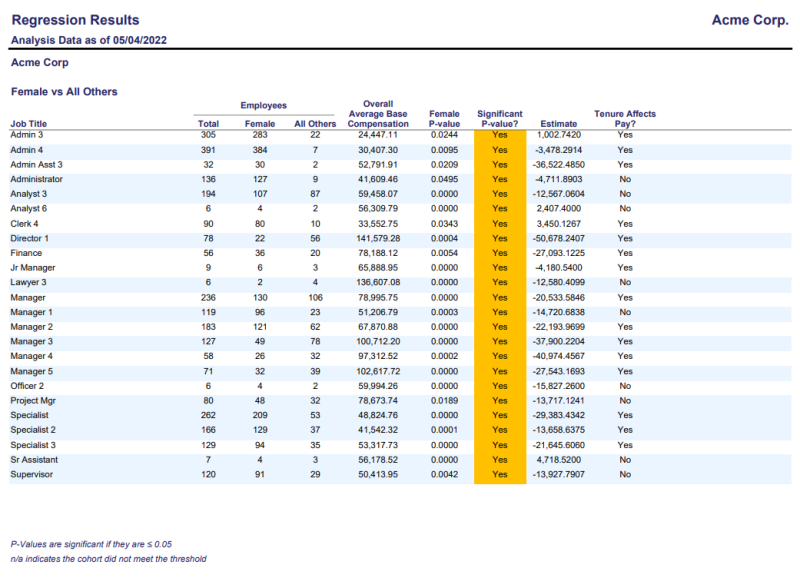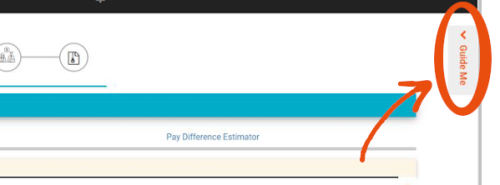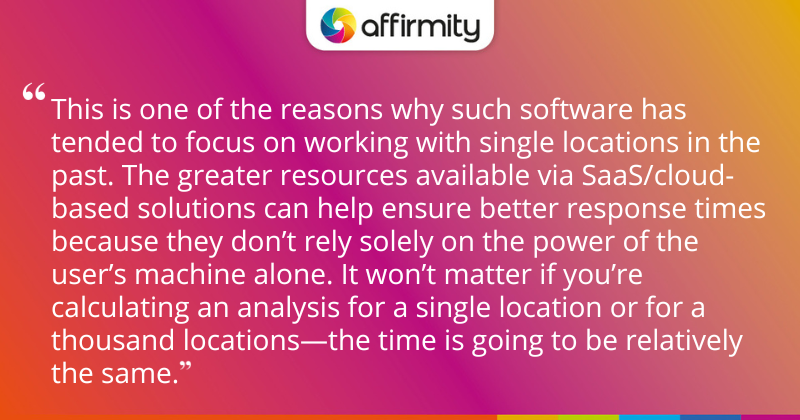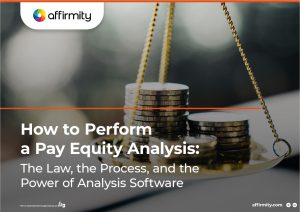Software exists to do the heavy-lifting in your pay equity analysis—you should expect to be able to feed in all your data for a location and automatically receive a range of standard analysis types that highlight problem areas for you to focus on. However, a truly powerful piece of software will go beyond this. Here are six features anyone in the market for pay equity analysis software should look for.
A lot of pay equity analysis is done “after the fact”—an organization is under audit and it wants to check what the OFCCP will potentially find out. A software-based approach will make it easier for organizations to take a more proactive approach—you can run analyses preemptively. Pay equity analysis software will also help you change your relationship with consultants—you may be able to use them more flexibly if software helps you become self-sufficient in terms of raw number crunching.
Some key features to look out for in your software are:
1) A Wide Range of Analysis Types

Example of regression analysis results performed in Affirmity PayStat.
Ideally, your software will take data from multiple locations and allow you to run a range of typical analysis types, including:
- Regression analyses
- Rank-Sum analyses
- t-Test analyses
THE IMPORTANCE OF CONSOLIDATING EQUITY EFFORTS | ‘How to Connect Your Pay Reporting Requirements to Your Pay Equity Efforts’
2) Total Analysis for All Your Locations
Pay equity analysis software typically focuses on analyzing a single location at a time, which is certainly still a valid workflow for many businesses. However, if you’re an organization with 100, 200, or even thousands of locations, running individual analyses and cross-referencing them simply isn’t practical.
Affirmity’s own pay equity analysis solution is PayStat®, a cloud-based Software as a Service (SaaS) solution designed to help you scale up these types of analyses to your entire organization.
By having all the data for your organization in one place, you can look at any relevant focus point within the organization: locations, divisions, business units, regions, districts, or the entire company as a whole. This allows you to really focus on where you believe the issue sits and tackle it more effectively. Addressing issues at the widest possible level is likely to offer more permanent solutions than a location-based approach.
3) Easy-to-Follow Processes and Interface

If software is going to make analysis easier, it ideally needs to teach you how to use it. One of the ways it should do this is by making important features easy to find, and by helping you understand how each feature relates to any other feature.
One of PayStat’s design goals was to lay out its options clearly in a sequential process, as you can see in the screenshot above. So for example, once you’ve worked with one of the analysis types listed earlier, and determined where differences are not the consequence of the organization’s own standards, you could progress to the tool’s pay difference estimator to determine how much back pay you may need to allocate to correct the inequity.
FROM OUR VIDEO SERIES | ‘OFCCP Compliance Series: How to Review Compensation to Identify Pay Disparities’
4) Support With Analysis and Within the Tool

As established, your analysis tools are only powerful if you’re given every opportunity to understand how they work. If you’re in the market for a pay gap analysis tool, fully investigate your options for support with that tool. Is there a knowledge base that will answer your questions, and how is that delivered?
Another PayStat design goal was to have as much information as possible available in the tool. This is why a “Guide Me” tab can be opened at any time for access to additional tutorial videos and documentation.
Support outside the tool is important too—you could work with analysts to set up appropriate analyses and should always expect to be able to ask your vendor questions on how to use the tool if help features don’t provide the answers you need.
5) Quick Query Response and Less Downtime
The pay equity analysis process requires you to investigate your data through a range of different lenses—you may need to work with different groups, different variables, and different timescales to uncover issues and their root causes. Working through all of these different perspectives is going to be a painful experience if you’re left waiting for more than a few seconds for everything to be calculated.
This is one of the reasons why such software has tended to focus on working with single locations in the past. The greater resources available via SaaS/cloud-based solutions can help ensure better response times because they don’t rely solely on the power of the user’s machine alone. It won’t matter if you’re calculating an analysis for a single location or for a thousand locations—the time is going to be relatively the same.
EQUITY WITHIN DE&I | ‘How Comerica Builds Momentum in Its DE&I Strategy [Q&A]’
6) Make Sure Your Data Is Secure
It goes without saying that pay equity data is sensitive information. If you want to take advantage of the benefits of a cloud-based system, it’s important that you work with a provider who will encrypt the data and work to stringent data protection standards within their data centers.

Continue Reading: Learn About Pay Equity Law and Process
This blog post is an extract from our ebook, ‘How to Perform a Pay Equity Analysis: The Law, the Process, and the Power of Analysis Software’. In the full ebook we look at the wider issue of pay equity such as your obligations under the law, as well as the full process for anyone investigating and tackling pay inequality.
Read the full ebook to learn more about:
- Established pay equity laws
- New trends in pay equity law that organizations must pay attention to
- Defining, planning, and performing a pay equity analysis
- What you need to do once you have uncovered pay inequality

If you would like to learn more about Affirmity’s own pay equity analysis software solution, PayStat, contact us for a demo.
 About the Author
About the Author
Roy Zambonino is a senior solutions consultant at Affirmity. He is responsible for demonstrating and discussing Affirmity’s wide range of DE&I and affirmative action planning products and services with existing and prospective clients.
As a former project manager, Mr. Zambonino is able to draw upon the best practices he’s observed over the last 20+ years helping prepare and implement programs. This work has involved companies ranging in size from a few hundred to several hundreds of thousands of employees, and spans across many industries including retail, construction, healthcare, banking, and finance. Mr. Zambonino has a Bachelor’s and Master’s degree in Business Administration.
